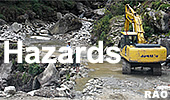| Natural Hazards in Bhutan |
 |
Bhutan Earthquakes |
 |
Before
Earthquake |
 |
During
Earthquake |
 |
After
Earthquake |
|
|
 |
|
Before
Earthquake: Tips
|
 |
| Check
before |
 |
These
are some actions you can take to prepare for an earthquake:
1.
Develop and carry out a family emergency plan
2.
Prepare emergency supplies
3.
Prepare an emergency kit
4.
Safeguard your home by regular maintenance
5.
Make your house earthquake-resistant |
top
 Develop
and Carry out a Family Emergency Plan Develop
and Carry out a Family Emergency Plan |
 |
 |
 |
Explain
the earthquake risk and discuss the emergency plan with your family. |
 |
Identify
the safe and unsafe places in each room at home (and in the office). Safe
places are under well-built furniture such as heavy tables, against an
inside wall, close to door frames and supporting pillars. Also find out
the best way to escape from each room. |
 |
Identify
the safe and unsafe places in each room at home (and in the office). Safe
places are under well-built furniture such as heavy tables, against an
inside wall, close to door frames and supporting pillars. Also find out
the best way to escape from each room. |
 |
Identify
a safe place outside your home. The safe places are empty fields away from
buildings, trees, telephone and electrical lines etc. |
 |
Ask
an out-of-city/country relative or friend to be your family's contact.
Family members should call this person and tell them where they are if
they are unable to go or call home. |
 |
Teach
each family member what to do during an earthquake, and reinforce the learning
by having drills. |
 |
Show
each family member how and when to turn off the water, gas, and electricity
supply at the main sources. |
 |
Know
where the nearest fire, police stations and emergency medical centres are,
as well as those who can help you during an emergency. For example, a neighbour
who is a doctor. |
 |
Plan
for people with special needs such as babies, the elderly, and the pregnant. |
 |
Paste
a list of updated emergency telephone numbers on your telephone. |
 |
Stock
emergency supplies. Change the items every six months. Stock some supplies
in the office too. |
 |
Assemble
an emergency kit in an easy-to-carry bag. Prepare one kit each for your
home, car and office. Change the items every six months. |
 |
Learn
first-aid. |
 |
Learn
to use the fire extinguisher. |
 |
Coordinate
an emergency plan with your children's school and your neighbours. |
top
 Prepare
Emergency Supplies Prepare
Emergency Supplies |
 |
Stock
some supplies in your home and office. Change the items every six months.
 |
Adequate
supplies of medications that you or your family members are taking |
 |
Tools
to turn off electricity, gas and water supplies (and place at the main
source) |
 |
First-aid
kit and handbook |
 |
Drinking
water for each family member for at least 3 days (allow at least 1 gallon
per person per day) |
 |
Non-perishable
food such as canned and package foods, dried fruits and nuts, salt, sugar,
cereals, beaten rice, lakhamari, dalmoth etc. Remember to cater for family
members with special needs (for example milk powder for the baby). |
 |
Camp
stove or barbecue to cook outdoors (with fuel stored out of the reach of
children) |
 |
Clothing
materials such as underwear, shoes, blankets etc. |
 |
Sanitary
materials such as toilet papers, soaps, plastic garbage bags, personal
hygiene items etc. |
top
 Prepare
Emergency Kit Prepare
Emergency Kit |
 |
These
things should already be packed in an easy-to-carry bag, ready for any
emergency. Prepare one kit each for your home, car and office. Change the
items every six months.
 |
Adequate
supplies of medications that you or your family members are taking |
 |
Drinking
water, in 1 or 2 liters bottles |
 |
Non-perishable
food such as canned and package foods, dried fruits and nuts, cereals,
beaten rice, lakhamari, dalmoth etc. |
 |
Flashlights
with extra bulbs and batteries |
 |
Portable
radio with extra batteries |
 |
Water
purifier tablets |
 |
Mechanical
can opener or Swiss army knife |
 |
Copies
of important family Publications(such as birth and marriage certificates,
passports, insurance papers, bank Publicationsetc.) and important telephone
numbers. |
 |
Copies
of your house plan (useful in case of search and rescue action) |
 |
Money |
 |
Duplicate
set of keys |
top
 Safeguard
your home by regular maintenance Safeguard
your home by regular maintenance |
 |
 |
Store
large, heavy or fragile objects on lower shelves or in low, closed cabinets
>> Remove flower pots from balconies and parapets |
 |
Hang
pictures and mirrors away from beds |
 |
Repair
damaged electrical wiring and leaky gas connections |
 |
Bolt
tall furniture and appliances such as bookshelves, refrigerators to walls |
 |
Bolt
tall furniture and appliances such as bookshelves, refrigerators to walls |
 |
Limit
the sliding and rocking movement of furniture and electrical appliances
by using Velcro, straps, non-slip mats etc. |
 |
Use
positive-latches such as childproof latches in cabinets |
 |
Support
overhead light fixtures and fans with extra cables |
| This
article was contributed by KUENSEL, Bhutan's National Newspaper 2004
|
 |
| Information on Bhutan |
 |
|



